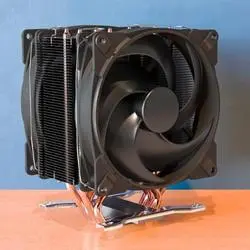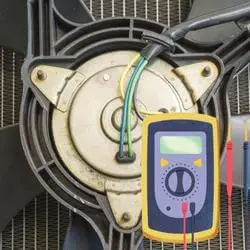A multimeter can test many components in your car. Here is a step-by-step guide on how to test a radiator fan with a multimeter. Testing a radiator fan is easy on a multimeter, and it will save you from buying a new one.
Our motor cars have a radiator fan whose function is to cool down the engine when it gets heated. The engine gets heated when we drive the car for a long distance or if we drive it uphill, so in this case, the radiator fan works and helps to provide the cooling effect to engines so that it cannot get damaged and continue working.
But sometimes it happens that because of some reason the radiator fan is not able to do its task anymore so it will directly lead to the damage of the engine.
In this case, we should know how to test the radiator fan if we see our engine getting overheated again and again. The proper guidance is necessary so that you can immediately give a check to your radiator fan.
Table of Contents
ToggleTypes of radiator fans:
As we have different types of cars, the radiator fans are also different; there are two types of radiator fans.
- Electric radiator fan
- Manual radiator fan
The first is the electric radiator fan, and the second is the manual radiator fan.
These radiator fans work differently, but their function is to cool down the engine and decrease the temperature so your motor car can continue its journey.
The difference between electric and manual radiator fans is that if an electric radiator fan is present, it has connected to the car through wires. The connection depends upon the water pump if a manual radiator fan is present. A belt covers the whole system, from which the water gets pumped and cools down the engine.
Any type from both of them can get damaged, and the best thing is that we can check both types of radiator fans using the same technique while using a very handy tool, the digital multimeter.
So, first of all, we will check out the main reasons which can cause damage to the radiator fans. If you see any of the given symptoms in your radiator fan or its capacitor, then it means that you immediately have to perform the test we are going to guide you about in this article.
Symptoms of a damaged radiator fan:
If you have the electric type of radiator fan in your motor car, the following symptoms can cause your radiator fan to get damaged.
- If there is an electric radiator fan in our motor car, the first and the most basic reason that can cause damage can be damaged connectors or broken wires.
See if there is any breakage in the wires of the radiator system present or not. If you see any damage there, it means your radiator fan has a problem with it, for which you have to alternate the wires of the electric radiator fan.
- The second reason for the fault in the electric radiator fans can be the damaged relay. If the relay of your electric radiator fan has got burnt, then the radiator fan will not be able to stop and will run continuously, which is also a type of severe defect.
- Suppose any electrical short occurs in the electric radiator fan’s electric system. In that case, it can damage the fuse of the radiator fan, because of which the radiator fan will not receive any electrical current. This is also a type of electric radiator fan fault.
- If any of the sensors of the electric radiator fan, like the temperature switch or temperature sensor, has got damaged, then the radiator fan will not be able to work.
- If the motor of the radiator fan gets burnt, it will not let it do its work.
If there is a manual or mechanical radiator fan in your motor car, then the following reasons can cause damage to your radiator fan:
- If the clutch of your manual radiator fan gets damaged, then it will not let the manual radiator fan produce the cooling effect for your overheated engine.
- If the belt of your manual radiator fan gets damaged or broken down, the whole function will get stuck, and the radiator fan will get damaged properly. In this case, you must replace the belts, so the radiator fan starts working normally again.
So if you see any of the symptoms mentioned above in your radiator fan, it is time to give it a brief check-up using the digital multimeter. We will guide you on how to test the radiator fan with a multimeter.
How to test the radiator fan using a multimeter?
Precautionary measures:
Whenever you start the test of checking the radiator fan by using a digital multimeter, you should turn off the power to the radiator to make sure that no current is passing from the circuit so that you can easily check the radiator fan.
As there are two types of radiator fans, we will first discuss how to test the electric radiator fan by using the digital multimeter.
How to test the electric radiator fan with a multimeter?
Quick steps:
- Start the engine of the car.
- Set the digital multimeter on the volts setting.
- Voice of the digital multimeter with the electric radiator fan.
- Check the results.
We will briefly explain the procedure for testing the electric radiator fan using the digital multimeter.
Step 1:
Now we have to check the electric radiator fan, so first, we have to let it start. Start the car’s engine and give it pressure until the radiator fan starts.
Step 2:
In the second step, you have to set the digital multimeter on the volts setting. For this, you have to turn the dial of the digital multimeter towards the volt option. Now the multimeter is ready to calculate the voltage of the electric radiator fan.
Step 3:
Connecting the digital multimeter to the electric radiator fan is important for conducting the test. So in the third step, you have to connect one lead of the digital multimeter to the electrical connection of the radiator fan and the second lead of the digital multimeter to the ground.
Step 4:
After connecting the leads of the digital multimeter to the electrical system of the radiator fan, the digital multimeter will start getting the readings of the voltage of the electric radiator fan. Now in the 4th step, you have to read the voltage readings from the digital multimeter’s screen. If you see the results around 12 volts, then it means that there is no problem with the power of the radiator fan.
If you see the results of a great difference with 12 volts, then it means you have to replace the electric radiator fan immediately. And if you see no voltage readings on the screen of the digital multimeter, then it means that there is a fault in the fuses of the electrical radiator fans. So for this, you have to change the fuses here.
How to test the manual radiator fan with a multimeter?
The first step of testing the manual radiator fan by using the multimeter is that you have to know if your manual radiator fan has a fan clutch or not.
Have fan clutch:
- If your manual radiator fan contains a fan clutch, then you have to test the RPM of the motor of the manual radiator fan.
- Check the RPM value by using the digital multimeter.
- If the resulting RPM value of the radiator fan is more than the motor, then it means that there is no problem with the fan clutch of the manual radiator fan.
Have no fan clutch:
- If the manual radiator fan of your motor car has no fan clutch, then there will be a fault present in the belt of the manual radiator fan
- See if there is any physical damage you can see on the belt of the manual radiator fan
- It is obvious that there is some point where the damages are present on the belt of the manual radiator fan
- In this case, you have to replace the belt so that your radiator fan starts working again.
- It is good news that you only have to replace the belt, not the whole radiator fan.
Frequently asked questions
What factors cause the radiator fan to turn on?
The radiator fan gets on when the engine produces more heat than the standard level.
Can we use the car batteries to test the radiator fan?
The car batteries can also help us to test the radiator fans.
Can I still have to test the radiator fan if the wire of my radiator fan is damaged?
A: If the wire of the radiator fan is damaged, then it means that it can be the main cause of the faulty radiator fan, but still, you are advised to perform the proper test by using a digital multimeter to check the radiator fan. It will be helpful and provide you with accurate detail about the fault of the radiator fan.
Does it require good experience to test the radiator fan using the digital multimeter?
Digital multimeters can provide results with minimum techniques and experience. You can also test the radiator fan using the digital multimeter if you have little experience.
Does the thermal fan clutch also be the reason for a faulty radiator fan?
A: Thermal fan clutch controls the power of the radiator fan. When the engine starts getting heated up, it gives a signal to the thermal fan clutch, which in turn, turns on the radiator fan.
So if the thermal fan clutch is damaged, the radiator fan will not be able to get on. So if you do not see any problem in the test, you can check the thermal fan clutch to know the root cause of the problem.
Conclusion
Radiator fans have a great function of managing the temperature of the engine of cars. Although different engines produce different heat values, if their radiator fan is not working properly, it will cause severe damage to the car’s engine, which is the basic component of the car system.
In this case, you should know how you can check the radiator fan of your car by using the digital multimeter so that if this condition occurs at any point on your way, you can solve the problem by yourself. Check out the symptoms given here, which will help you know what problems can lead your radiator fan to serious damage.
Follow the guidelines and give a brief check-up to the radiator fan of your car.
Related Guides:




